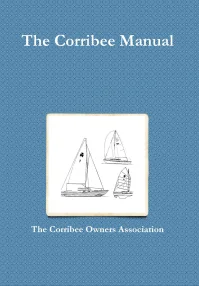Fore hatch
The standard hatch on a Corribee is a grp moulding, though the shape varies according to the age of the boat. The Mk 2 has a rectangular hatch but the later models have a slightly larger trapezoidal shaped opening (which will be a bit more difficult to modify). The central section is non-pigmented – not exactly transparent, even when new, and fairly opaque after a few years of exposure to the sun. It also lacks strength and is prone to jamming when it has been stepped on. Casulen II’s hatch, shown below, is a Vetus Planus. Some modification of the existing opening is needed to ensure that it is bolted down to a flat surface. The flange is sealed in place with a suitable marine sealant and, like the windows above, has been subjected to some very wet sailing conditions without leaking.


The following comments from owners may be of interest:
Lost hatch
I could really do with some advice. I have had a really bad two years, and in quick succession had stolen my much cursed long shaft 5hp Seagull, lost my fore hatch cover (vanished who knows where leaving a very wet boat when I discovered it a few weeks of winter rain later), and broke the roller furling mechanism on my boom. (1979 mark 2 Corribee called Prawn).
—–
We lost our forehatch as well. We went to the local chandlers and got some catalogues to browse through, and now have a much improved hinged hatch with opening acrylic window. It looks much better than the old one, and is much more practical. The make we ended up with is a Vetus Planus escape hatch, Dutch I think. I don’t have an exact model number. It was necessary to sand down the hatchway to get it flat before fitting, and it does not leak at all. Hope this helps
Kathleen
—–
I have an eye fixed to the rear of my forehatch with a length of shockcord(bungey) led through it and back to another eye under the deck. this is a good “preventer”, should the forehatch latches fail. The length of the shockcord may be adjusted to allow the hatch to open fully and will stop the hatch from blowing away if not closed.
Morris Metcalf
Source: corribee.org.uk
Contribute
Do you have a story, information, brochure, manual, link or other relevant content that should be on this page? If so, we would be very grateful if you would leave it as a comment or email corribeeeditors@googlemail.com so we can post here – thanks!



March 26, 2015 at 17:40 |
Thank you all for your advice – Just ordered a Vetus 4040 for my Mk2 found one on line for £150 including delivery
December 12, 2012 at 17:56 |
Hi,
resently I bought a MKII Corribee. My fore hatch has been replaced to a home made one. Has somebody a used fore hatch ???
Thanks, Nico from Kiel
May 9, 2012 at 13:50 |
Having just fitted a Vetus Planus hatch to a Mk II Corribee (i.e. one with a trapezoid opening, I can confirm their suitability and excellent build quality. However, don’t be influenced by the illustration posted above into going for the 45×45 escape hatch (I did) – it is too big – the one that fits is the 40×40 deck hatch. I found that it was necessary only to sand down the central fore and aft surfaces of the combing, but mouldings might vary.
October 3, 2010 at 18:32 |
how much sanding does the fore hatch need to fit the vetus planus hatch?
Can anyone help?
September 4, 2011 at 17:45 |
Very little. A Vetus was too large for my particular forehatch, but I managed to get a smaller glass hatch from a different manufacturer from the Dauntless Boatyard in Benflee, Essex. After cutting the shape and bolting on using a good amount of sealant, I used six small screws to secure the hatch back into its normal position, along with a considerable amount of sealant. Result: superb. Looks great and is totally watertight. Adds extra light and ventilation to forecabin at very little cost or time.